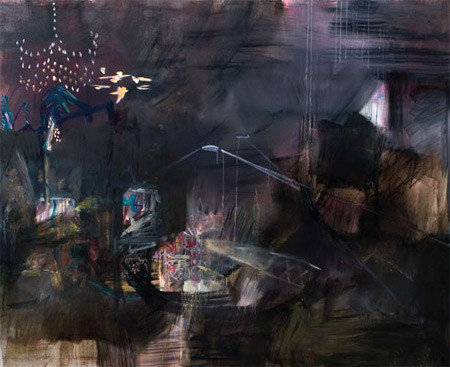Through a Glass, Darkly
dal 23/4/2008 al 23/5/2008
Segnalato da
Nick Goss
Elinor Evans
Matthew Murphy
Thorbjorn Andersen
Gereon Krebber
Maria Glyka
Vassilis Vlastaras
Maria Glyka
Carali McCall
Sonia Almeida
DaeWha Kang
Annabel Emson
23/4/2008
Through a Glass, Darkly
Kenny Schachter Rove, London
An exhibition of 10 contemporary artists curated by Annabel Emson and architecturally curated by DaeWha Kang. The gallery becomes a glass or a lens through which the art is seen anew.

curated by Annabel Emson and by DaeWha Kang
Kenny Schachter ROVE is pleased to present ‘Through a Glass, Darkly’, an exhibition of 10 contemporary artists curated by Annabel Emson and architecturally curated by DaeWha Kang.
‘from darkness we see light
from the hidden we uncover the revealed
from obscurity we discern clarity’.
Architecture is a binding force. It is an organizing element, and it makes an atmosphere. In this show, the mediums of architecture and artwork are alchemically combined, transforming the perception of space, reflection, shadow and light from the boundaries of two and three-dimensional fields into a living environment. The gallery becomes a glass or a lens through which the art is seen anew.
The other world of a reflected side can be seen through distant memories in Sonia Almeida’s work. Almeida’s paintings shout back in time, listening for the echo that appears on the canvas; distilling the essential, and leaving the memory of a color or a shape from somewhere else. This somewhere else, this window into another space, is evident in a number of the artists' pieces. Annabel Emson’s ‘Dark Light’ opens up an atmosphere of a place where the relationships of the paradoxical reflect off each other; the light is seen through the darkness. A dark painting becomes a light painting through the essence of its darkness. In Nick Goss’ landscapes, obscured light reveals buildings, traces of human civilization left on the edge. These places belong to another time and are now remnants, artifacts of solitude. Elinor Evans’ paintings play with this element of self-reflection. Humans wear or hide behind animal masks; addressing the space between animalistic nature and the faces worn in society. Through the fluid texture of moving image Evans creates a dialogue between the face shown and the true face: in essence our reflection. The artist challenges the viewer to address their own nature through their relationship to animals, their primeval nature and honesty to the shamanic culture within. Taken on from here Matthew Murphy’s paintings and watercolors explore the realm and boundaries of not only the mind but also the physical anatomy; Murphy transforms the space of the body. The space of an eye looking on is reflected back onto the viewer, the looker becomes the looked at. Anatomy converges and transcends into shapes and spaces outside the realm of scale or structure of the usual architecture of a body, into another realm.
In this realm of the reconstructed there exists a new space that can be seen through the paintings and works of Thorbjorn Andersen. Paintings become abstract, geometrical, two-dimensional sculptures simultaneously dense and transparent. The space in these paintings reflect light through darkness, the edges of the work conceptually extend out into the geometric space of the architecturally rendered gallery, where the essence of light and darkness are used to create space and structure. As the artwork and gallery reflect through, over, and under each other, obstructing and facilitating each other, the viewer is confronted with the work of Gereon Krebber. Krebber’s obstructions and protrusions mould themselves around the gallery making difficult space. The sculptures create problems: through their awkwardness they create a platform of awareness. A perception where the space is realized from the problem, the viewer becomes aware of this big thing or this floating object, or this jellied floor. The problems posed by the sculptures allow the viewer to see that space in the floor or that corner of the wall in a new light: to get around it, to move past it, to understand how it got there. The sculptures reflect back onto the looker the negative space of the ‘thing’, which has obstructed itself into the gallery. Cutting away blind acceptance the space is seen clearly through the lens of these sculptures.
Tugged away from this rugged awareness the viewer is folded and unfolded into the ephemeral materials of Maria Glyka, optical echoes of previously rendered scenes: that which is hidden, secretly opened, revealed and folded back in on itself. Vassilis Vlastaras and Maria Glyka collaborate across an ‘architectural’ bridge dialoguing between the hidden and the seen, the obscured and the revealed, the domestic and the social context of perception. A dialogue between spaces, between rooms, between each other, they create. In Carali McCall's work the body is the sculpture through which the work is performed.. The artist as sculpture; process being the image, and one that never ends but by the exhaustion of endurance. The image is finished not by the edge of a canvas but by the edge of a human’s ability to continue in time. As one looks into these circles one see through them into a realm where time is the material and the body the vessel of a movement--a raw energy--a light that eventually returns to darkness and a darkness that gives birth to light.
‘Through a glass, darkly’ carries its audience along an obscured line reflecting through paradoxes, stretching from the artist’s body to the external limits of the walls of the gallery. The space as atmosphere, a looking glass into other worlds within worlds.
Private view Friday 25 April 6 - 9 pm
Kenny Schachter Rove
17 Britannia Street - Kenny Schachter Rove - London
Free admission



